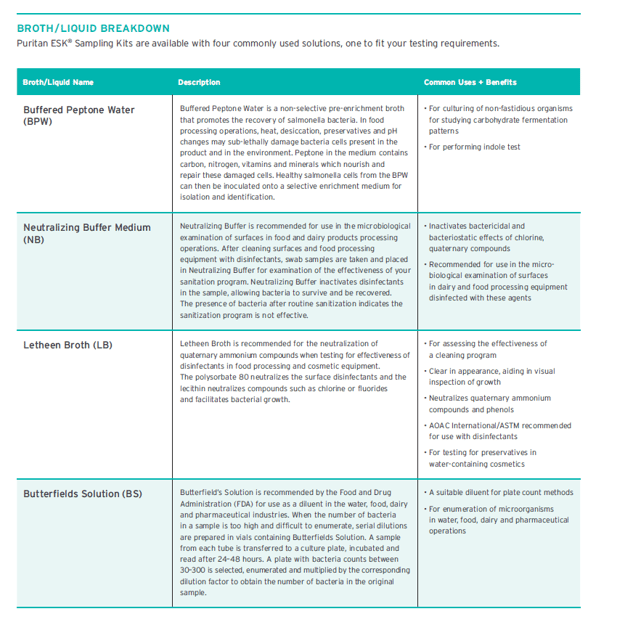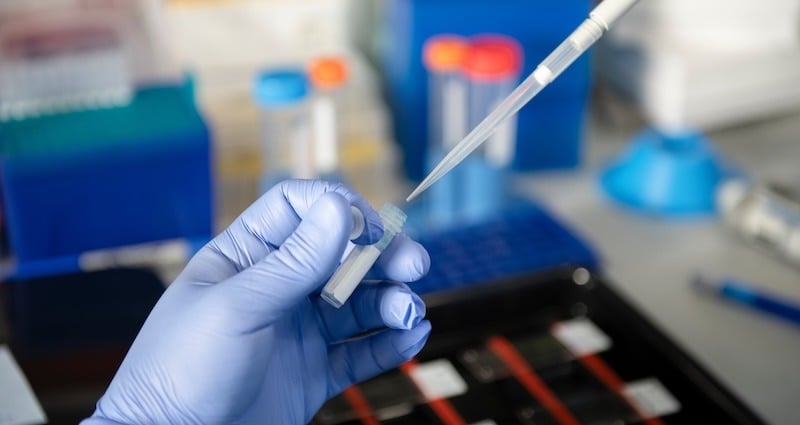
Are you looking for a resource that outlines everything you need to know before purchasing an environmental sampling product for your business? You’ve come to the right place.
From the basics of environmental sampling products to the details of which sampling product is best for your process, we’re breaking down all of the information you need to inform your purchasing decisions.
What is environmental sampling?
Environmental sampling is the process of collecting samples of air, water, soil, or biota to analyze the condition of the environment and assess the levels of pollutants or contaminants present. This scientific method is used to monitor and evaluate the quality of the environment, which includes detecting changes over time, identifying potential environmental hazards, and ensuring compliance with environmental standards.
The primary goal of environmental sampling is to obtain representative samples that accurately reflect the conditions of the environment being tested. These samples are then analyzed in a laboratory to measure various parameters such as chemical concentrations, microbial presence, and adulterating materials, like metal or plastic pieces. The results provide crucial data that can influence public health policies, industrial practices, and environmental management strategies.
What Are the Benefits of Environmental Sampling?
Environmental sampling is a fundamental practice across various industries and disciplines, serving as a critical tool for assessing and managing the health of ecosystems, ensuring public safety, and complying with environmental regulations. The importance of environmental sampling is multi-faceted, impacting everything from public health to regulatory compliance and environmental conservation.
Let’s take a closer look at the key reasons why environmental sampling is a crucial practice for several industries:
1. Environmental sampling helps monitor and protect public health
Environmental sampling plays a crucial role in public health by detecting contaminants that pose health risks to humans. This involves the systematic collection and analysis of air, water, and soil samples to identify pollutants like lead, pesticides, and microbial pathogens. By monitoring these environmental factors, health officials can swiftly identify potential risks and implement measures to mitigate them, thereby preventing disease outbreaks and reducing exposure to harmful substances.
While much of environmental sampling focuses on naturally occurring contaminants from sources like agricultural runoff or industrial discharges, there is also a growing concern over intentional adulteration. For example, public water systems are not only tested for naturally occurring contaminants but also for potential bio-terrorist threats, a concern primarily managed by the Environmental Protection Agency (EPA). Similarly, the pharmaceutical industry has enhanced its environmental sampling practices following past incidents of intentional contamination, such as the Tylenol poisoning case, which led to significant improvements in the safety packaging of over-the-counter medicines.
This proactive approach is vital for safeguarding public health, allowing for quick action in the face of potential environmental threats, whether they are natural or intentional. By continually adapting to new challenges, environmental sampling serves as a critical line of defense, ensuring public health protections keep pace with evolving environmental and industrial landscapes.
2. Environmental sampling ensures compliance with environmental regulations
Strict environmental standards and regulations are in place to protect air, water, and soil quality. Environmental sampling is essential for ensuring that industries such as manufacturing, agriculture, and waste management adhere to these regulations. Regular sampling helps authorities enforce laws by providing evidence of compliance or non-compliance. For companies, staying in compliance not only helps avoid legal penalties but also maintains their reputation and operational licenses.
3. Environmental sampling supports environmental sustainability
Environmental sampling helps scientists and researchers understand the baseline conditions of an ecosystem, detect changes over time, and assess the impact of human activities. This information is crucial for developing strategies to protect endangered species, conserve habitats, and manage natural resources sustainably. For instance, sampling water bodies before and after industrial activities can help in evaluating the impact of pollutants and the effectiveness of mitigation measures.
4. Environmental sampling facilitates scientific research and development
Researchers rely on environmental sampling to collect data for studies on environmental science, ecology, and public health. This data is vital for developing new technologies, pollution control methods, and environmental management practices. It also aids in the modeling of environmental phenomena such as climate change, helping predict future conditions and plan accordingly.
5. Environmental sampling enhances industry processes and safety
In industries like pharmaceuticals, food processing, and cosmetics, environmental sampling ensures that the production environments are free of contaminants that could compromise product quality and safety. This not only helps in adhering to health and safety standards but also prevents costly recalls and protects consumer safety.
6. Environmental sampling supports crisis management and response
In the event of environmental disasters such as oil spills, chemical leaks, or nuclear accidents, rapid and effective environmental sampling is critical for assessing the extent of contamination and guiding cleanup efforts. This helps minimize environmental damage and health risks to the affected populations.
The Crucial Role of Environmental Sampling Across Industries
Environmental sampling plays a vital role in a myriad of industries, acting as the first line of defense in identifying potential hazards and ensuring compliance with safety standards.
For instance, in the food industry, environmental sampling is fundamental for detecting pathogens like Salmonella or Listeria in processing facilities, directly influencing food safety and public health.
According to the Centers for Disease Control and Prevention (CDC), environmental sampling helped decrease the occurrence of Listeria-related outbreaks by 58% in food processing environments between 1998 and 2018.
Which industries benefit from environmental sampling kits?
Industries that utilize environmental sampling are typically highly regulated, requiring adherence to health and safety protocols. The key industries that require this include:
Medical
The medical industry must be sterile and clean to ensure patients are not subjected to harmful germs while undergoing care. From swabbing surgical rooms, to cleaning medical instruments, ongoing environmental sampling is needed to ensure it’s safe for healthcare professionals to carry out their jobs.
Veterinary
Similar to the medical industry, veterinarians require a sterile environment when caring for sick animals. All and all, most of the same rules apply to vets that are required in the medical industry.
Pharmaceuticals / biotech
Having a clean environment free of pathogens is required in the manufacturing process to help ensure pharmaceuticals and biopharmaceuticals are safe for patients to use.
Cosmetics
While the FDA doesn’t have as stringent of oversight for cosmetics as it does on food and medicines, it still oversees cosmetic development to ensure they are safe for people to use.
Food preparation
This one should be a given because we all want our food prepared in an environment free of harmful chemicals and pathogens (such as salmonella, listeria, staph or E. coli). From food preparation to packaging to serving, there are stringent practices in place to ensure food is safe to consume.
No matter what industry you’re a part of, it’s important to recognize the unique needs of your business in order to purchase the appropriate product.
Here's a guide to environmental sampling in various workspaces.
Which leads us to…
What is Environmental Swabbing?
Environmental swabbing is a surface testing method used to detect microbial contamination or chemical residues in critical areas such as food processing facilities, pharmaceutical cleanrooms, hospitals, and laboratories. Unlike environmental sampling methods that test air, water, or soil, swabbing targets specific high-risk surfaces where contamination may occur during or after cleaning.
This process involves wiping a sterile swab, usually made from polyester, foam, or flocked material, across a defined surface area. The swab is then placed into a transport medium and sent for laboratory analysis.
The goal of environmental swabbing is to detect pathogens (like Listeria, E. coli, or Staph aureus) or residues that could pose health risks or compromise product quality.
Environmental swabbing is commonly conducted:
- After cleaning and sanitization procedures to verify effectiveness
- Before production runs to validate surface cleanliness
- During routine environmental monitoring programs to comply with FDA, USDA, and ISO standards
Types of Environmental Swabs and Their Applications
Different environmental swabs are designed to optimize sample collection from various surface types and environments. But which is right for your application?
Here’s a quick guide to common environmental swab types:
|
Swab Type |
Best For |
Key Benefits |
|
Polyester-tipped |
Flat or smooth surfaces (e.g., tables, equipment panels) |
Low lint, durable, and compatible with most media |
|
Foam-tipped |
Rough or textured surfaces |
High absorbency and particle entrapment |
|
Cotton swabs |
General-purpose testing |
Cost-effective but lower microbial recovery, used for cleaning surfaces more than environmental sampling |
The best swab will depend on your unique application. Are you swabbing stainless steel conveyor belts? Inside the crevices of filling machines? Or perhaps packaging surfaces? There’s a swab designed for every environmental and compliance need.
Need help choosing? Chat with our team today.
How Environmental Swab Testing Works
Environmental swab testing is a straightforward but critical procedure that begins on the facility floor and ends in the lab.
Here’s how it typically works, using stainless steel as an example:
- Put latex gloves onto hands
- Open and remove your swab testing kit from its package, and place on a clean surface until ready for use.
- Hold the vial at a horizontal angle to prevent contaminants from entering the vial.
- Remove the swab from the vial by holding the cap and twisting counterclockwise.
- Using one side of the swab, select a sample area - it could be a small area of equipment, a narrow channel, or a drain.
- Collect a sample by vigorously rubbing the swab with firm pressure approximately 10 times in a vertical, up and down motion following a “Z” pattern.
- Turn swab to opposite side and swab approximately 10 times in a horizontal, side to side motion over the surface area being sampled.
- Swab diagonally using the same swab side as used in the vertical swabbing.
- Swab approximately 10 times in the sampling area until the opposite side’s bottom corner has been sampled.
- Upon completion of sample collection, aseptically return swab into corresponding vial, holding vial vertically to prevent contaminants from entering.
- Label vial with appropriate information.
- If immediate testing cannot be performed, place samples in a refrigerated area.
Looking for more details? Head on over to our guide on collecting samples from stainless steel.
What Can Be Collected with Environmental Swabs?
Environmental swabs are versatile tools capable of collecting a wide variety of environmental samples from both clean and contaminated areas.
Here are some common examples:
- Food Contact Surfaces: Tables, slicers, blenders, conveyors
- Air Handling Equipment: Grilles, ducts, or swabbed air filters
Non-Food Contact Surfaces: Floors, walls, drains, light switches - Cleanroom Surfaces: Stainless steel benches, packaging areas, laminar flow hoods
- Biofilm Zones: Hard-to-clean or moist areas where microbial colonies form
Swabbing these zones allows your team to take a proactive approach to hygiene verification, regulatory compliance, and contamination control.
What are environmental swabbing kits?
From food to pharmaceuticals, cosmetics, and more, having a safe environment is key to your business success. Environmental sampling swabs and collection devices are used to test work areas for harmful chemicals and invisible pathogens that could halt your production efforts. Through carefully swabbing and testing the environment, you can identify contamination before you move forward with production and before packaging for distribution.
For example, our ESK® environmental sampling kits are used for environmental monitoring, hygiene control, sanitization programs and bioburden determination across a range of industries, from food safety to pharmaceuticals.
What is included in an environmental sampling kit?
Environmental sampling kits can come in various shapes, sizes, and transport media depending on your unique business needs. Selecting from different handles, tips, and fill options will give you results that will aid in spot-checking nearly any surface, with high-quality results you can count on.
Your kit will usually contain:
-
Container
-
Cap
-
Swab
-
Sampling medium
Check out our Food Safety Catalog here

At Puritan, in order to ensure our ESK® sampling kits were appropriate for the varied applications of our diverse clients, we spent time in the marketplace with different end users. We studied your process, listened to your needs, then went to our R&D team to design the best environmental sampling swabs for any application.
What we ended up with was a line of environmental sampling products suitable for a wide array of applications. All of our ESK® sampling kits have a 3” polyester tip swab attached to a quick-turn, leak resistant cap, giving you optimum control.
What is an environmental sampling medium?
Puritan’s four ESK® environmental sampling kits differ from one another in medium option, all available in either 4 ml or 10 ml configurations, each with its own specific use:
-
Neutralizing Buffer
-
Buffered Peptone Water
-
Letheen Broth
-
Butterfield's Solution
Each of these solutions allows you to test for different pathogens, giving you peace of mind and ensuring that your test results will be accurate and repeatable. We’ll get into the details further down when we define which product would be best for your operation.
Which environmental sampling product is right for your application?
Need help determining which of our environmental sampling kits is right for your specific application? We’re sharing details of the four different options.

Neutralizing Buffer
Neutralizing Buffer is recommended for use in microbiological examination of surfaces for food and dairy products. This medium has the ability to inactivate the bacteriostatic effect of chlorine as well as quaternary ammonium compounds.
This means after cleaning surfaces and food equipment with disinfectants, swab samples are taken to examine the effectiveness of the disinfectants. Neutralizing buffer medium neutralizes the antibacterial effect of such disinfectants on the swabs, thus allowing the bacteria to survive if they are present.
For example, Staphylococcus aureus is commonly found in post food processing contamination, which is generally due to human contact or contaminated food contact surfaces. The presence of a large number of Staph aureus bacteria in food indicates poor handling or poor sanitation.
Buffered Peptone Water
Buffered Peptone Water is used for pre-enrichment of injured salmonella species from food specimens prior to inoculation to a selective enriched medium for isolation and identification.
When salmonella species are present in food, certain food processing conditions such as heat, desiccation, preservatives and pH changes may injure bacteria cells. Therefore pre-enriched nonselective buffered peptone water medium allows for injured cells to repair and facilitate the recovery of salmonella. Peptone in the medium contains carbon, nitrogen, vitamins and minerals which injured cells consume to recover.
After salmonella cells are repaired and multiplied in the Buffered Peptone Water, they are transferred to a selective enriched medium for isolation and identification.
Letheen Broth
In the food and cosmetic industries, all work stations, equipment, and utensils used in daily processes are cleaned using different methods and disinfectants. Testing using Letheen Broth allows manufacturers to determine the effectiveness of their cleaning program by taking swab samples of cleaned equipment.
After collection, the samples are then transferred to the vial containing Letheen Broth medium, which neutralizes the surface disinfectants, chlorine, or fluorides, facilitating an environment in which bacteria may grow. The addition of polysorbate 80 to the medium neutralizes the surface disinfectants. Lecithin is added to neutralize quaternary ammonium compounds.
Butterfield's Solution
Butterfield's Solution is used for the dilution and enumeration of microorganisms in water, food, dairy, and pharmaceutical products. When the number of bacteria in a sample is too high (and thereby difficult to enumerate), serial dilutions are prepared in tubes containing Butterfield's Solution.
A sample from each tube is then transferred to a culture medium plate, incubated, and read after 24 hours. The plate with a bacteria count between 30-300 is selected and multiplied by the same dilution factor to obtain the number of bacteria in the original sample.

Don’t see the medium you’re looking for? We also We’re here to help. Contact us to discuss your needs. A custom configuration may be possible.
Ready to purchase your best-fit environmental sampling kit?
Hopefully this brief overview of the environmental sampling mediums contained in our ESK® sampling kits has given you a better idea of how to choose the right product for your specific application.
If you have any questions, or you would like to learn more about our ESK® line of environmental sampling products, don’t hesitate to contact one of our knowledgeable product specialists today.







